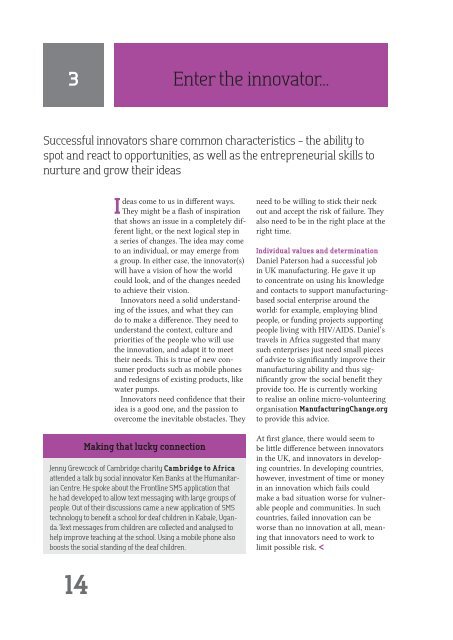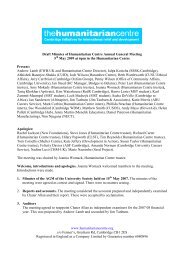Cambridge and international development - The Humanitarian Centre
Cambridge and international development - The Humanitarian Centre
Cambridge and international development - The Humanitarian Centre
Create successful ePaper yourself
Turn your PDF publications into a flip-book with our unique Google optimized e-Paper software.
3 Enter the innovator...<br />
Successful innovators share common characteristics – the ability to<br />
spot <strong>and</strong> react to opportunities, as well as the entrepreneurial skills to<br />
nurture <strong>and</strong> grow their ideas<br />
Ideas come to us in different ways.<br />
<strong>The</strong>y might be a flash of inspiration<br />
that shows an issue in a completely different<br />
light, or the next logical step in<br />
a series of changes. <strong>The</strong> idea may come<br />
to an individual, or may emerge from<br />
a group. In either case, the innovator(s)<br />
will have a vision of how the world<br />
could look, <strong>and</strong> of the changes needed<br />
to achieve their vision.<br />
Innovators need a solid underst<strong>and</strong>ing<br />
of the issues, <strong>and</strong> what they can<br />
do to make a difference. <strong>The</strong>y need to<br />
underst<strong>and</strong> the context, culture <strong>and</strong><br />
priorities of the people who will use<br />
the innovation, <strong>and</strong> adapt it to meet<br />
their needs. This is true of new consumer<br />
products such as mobile phones<br />
<strong>and</strong> redesigns of existing products, like<br />
water pumps.<br />
Innovators need confidence that their<br />
idea is a good one, <strong>and</strong> the passion to<br />
overcome the inevitable obstacles. <strong>The</strong>y<br />
Making that lucky connection<br />
Jenny Grewcock of <strong>Cambridge</strong> charity <strong>Cambridge</strong> to Africa<br />
attended a talk by social innovator Ken Banks at the <strong>Humanitarian</strong><br />
<strong>Centre</strong>. He spoke about the Frontline SMS application that<br />
he had developed to allow text messaging with large groups of<br />
people. Out of their discussions came a new application of SMS<br />
technology to benefit a school for deaf children in Kabale, Ug<strong>and</strong>a.<br />
Text messages from children are collected <strong>and</strong> analysed to<br />
help improve teaching at the school. Using a mobile phone also<br />
boosts the social st<strong>and</strong>ing of the deaf children.<br />
need to be willing to stick their neck<br />
out <strong>and</strong> accept the risk of failure. <strong>The</strong>y<br />
also need to be in the right place at the<br />
right time.<br />
Individual values <strong>and</strong> determination<br />
Daniel Paterson had a successful job<br />
in UK manufacturing. He gave it up<br />
to concentrate on using his knowledge<br />
<strong>and</strong> contacts to support manufacturingbased<br />
social enterprise around the<br />
world: for example, employing blind<br />
people, or funding projects supporting<br />
people living with HIV/AIDS. Daniel’s<br />
travels in Africa suggested that many<br />
such enterprises just need small pieces<br />
of advice to significantly improve their<br />
manufacturing ability <strong>and</strong> thus significantly<br />
grow the social benefit they<br />
provide too. He is currently working<br />
to realise an online micro-volunteering<br />
organisation ManufacturingChange.org<br />
to provide this advice.<br />
At first glance, there would seem to<br />
be little difference between innovators<br />
in the UK, <strong>and</strong> innovators in developing<br />
countries. In developing countries,<br />
however, investment of time or money<br />
in an innovation which fails could<br />
make a bad situation worse for vulnerable<br />
people <strong>and</strong> communities. In such<br />
countries, failed innovation can be<br />
worse than no innovation at all, meaning<br />
that innovators need to work to<br />
limit possible risk. <<br />
© Martin Edstrom<br />
14





